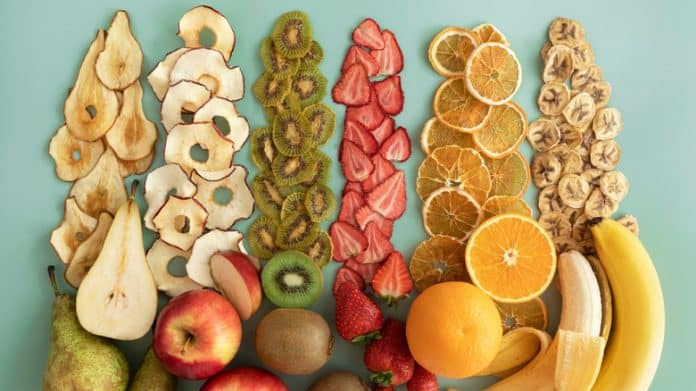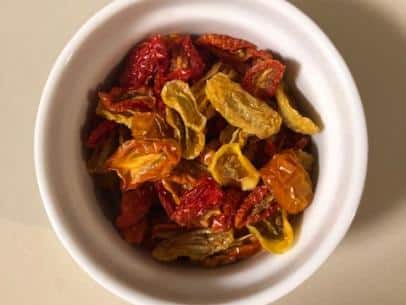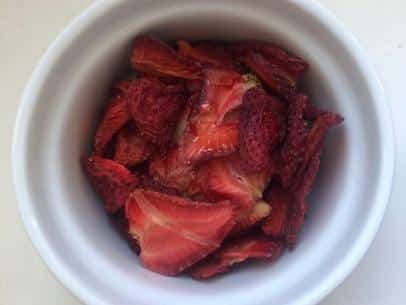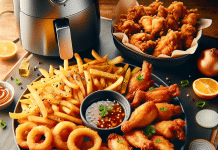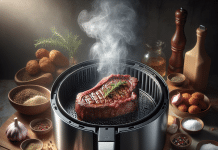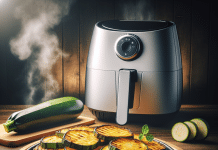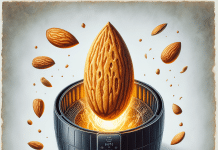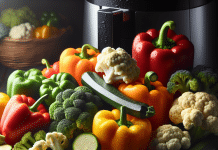Are you curious whether you can use your air fryer even more? Well, you’re in luck! This article’ll explore the fascinating world of dehydrating fruits and vegetables and how an air fryer can be your unexpected secret weapon.
Discover how this convenient kitchen appliance can transform your favorite produce into delicious, nutritious snacks perfect for on-the-go munching.
So, if you’re ready to take your air fryer skills to the next level, let’s jump right in!
Review contents
Factors to Consider
Temperature Settings
When using an air fryer to dehydrate fruits and vegetables, temperature settings play a crucial role in drying. It is essential to adjust the temperature carefully to ensure the food is not undercooked or overcooked. Most air fryers have adjustable temperature settings, allowing you to set the desired temperature according to the type of food you are drying.
Air Circulation
Air circulation is another factor to consider when dehydrating fruits and vegetables in an air fryer. Proper air circulation ensures the food is evenly dried and prevents any moisture from being trapped, which can lead to spoilage. Many air fryers are designed with a system that circulates hot air evenly, promoting efficient dehydration.
Size and Capacity
The size and capacity of your air fryer will determine how much food you can dehydrate at once. Consider the amount of fruits and vegetables you plan to dehydrate and choose an air fryer to accommodate that volume without overcrowding the basket. Overcrowding the basket can hinder proper air circulation and lead to uneven drying.
Type of Fruits and Vegetables
Different fruits and vegetables have different textures and moisture content, which can affect dehydration. Some fruits and vegetables may require longer drying times or different temperature settings to achieve optimal results. Knowing the specific requirements of the fruits and vegetables you are dehydrating is essential to ensure successful dehydration.
Preparing Fruits and Vegetables
Washing and Cleaning
Before dehydrating fruits and vegetables in an air fryer, it is essential to wash and clean them thoroughly. This removes any dirt, bacteria, or pesticides from the surface and ensures that you are drying clean and safe produce. Use cool water and a gentle scrub brush to clean the fruits and vegetables, and pat them dry before proceeding with dehydration.
Slicing and Cutting
Slicing and cutting the fruits and vegetables into uniform pieces is crucial for even drying. Aim for thin slices or small pieces, depending on the type of food you are drying. Thin slices allow faster and more efficient dehydration, exposing more surface area to the hot air. Invest in a good quality knife or mandoline slicer to achieve consistent thickness.
Pre-treating
Some fruits and vegetables may require pre-treating before dehydration to preserve their quality and prevent discoloration. For example, dipping apples in lemon juice can help prevent browning.
Blanching certain vegetables, like carrots and green beans, before drying can also improve their texture and color. Research the specific pre-treatment methods for the fruits and vegetables you plan to dry.
This image is the property of food.fnr.sndimg.com.
Dehydrating Process
Setting the Temperature
Once the fruits and vegetables are prepared, it’s time to set the temperature on your air fryer. Refer to the recommended temperature settings for the specific fruits and vegetables you are drying. Generally, a temperature range of 125°F to 160°F is ideal for most fruits and vegetables. Begin at a lower temperature and adjust as needed based on the progress of dehydration.
Arranging the Food
Properly arranging the food in the air fryer basket is essential for even drying. Avoid overcrowding the basket, as this can obstruct air circulation and result in unevenly dried food. Spread the slices or pieces of fruits and vegetables in a single layer, ensuring that there is some space between each piece. This will allow hot air to circulate evenly around the food, facilitating efficient dehydration.
Monitoring the Progress
During dehydration, it is essential to regularly monitor the progress of the fruits and vegetables in the air fryer. Check for signs of drying, such as shrinking and dehydrated texture, and adjust the temperature and time if necessary. Be patient, as the drying time can vary depending on the moisture content of the food and the air fryer’s performance.
Tips for Successful Dehydration
Use Thin Slices
To achieve optimal dehydration results, it is recommended to use thin slices of fruits and vegetables. Thinner slices allow for faster and more consistent drying, ensuring that the food is evenly dehydrated.
Ensure Even Placement
Properly arranging the food in the air fryer basket is crucial. Make sure to spread out the slices or pieces of fruits and vegetables in a single layer, without overcrowding the basket. This will promote even drying and prevent any areas from remaining moist.
Rotate and Flip Pieces
To ensure that all sides of the fruits and vegetables are evenly dehydrated, rotating and flipping the pieces during the drying process is advisable. This helps prevent areas from becoming overly dried or under-dried, resulting in uniformly dehydrated food.
Consider Preheating
Preheating the air fryer before placing the fruits and vegetables can help jumpstart the dehydration process. While not necessary, preheating can reduce the overall drying time and yield more efficient results.
This image is the property of food.fnr.sndimg.com.
Recommended Fruits and Vegetables
Apples
Apples are a popular choice for dehydration due to their natural sweetness and versatility. Sliced apples can be transformed into delicious apple chips or used in baked goods.
Strawberries
Dehydrated strawberries are a delightful snack with their concentrated flavor and chewy texture. They can also be added to cereals, trail mixes, or used as toppings for desserts.
Bananas
Dehydrated banana slices are a great addition to homemade granola bars, oatmeal, or smoothie bowls. They provide a natural sweetness and a satisfying chewiness.
Mangoes
Mangoes, when dehydrated, offer a burst of tropical flavor in every bite. Dehydrated mangoes can be enjoyed as a standalone snack or used in salads, salsas, or yogurt parfaits.
Tomatoes
Dehydrating tomatoes intensifies their flavor, making them perfect for adding to pasta dishes, pizzas, or sandwiches. They can also be powdered to create homemade tomato seasoning.
Zucchini
Dehydrated zucchini chips are a nutritious alternative to potato chips. They are packed with vitamins and minerals and can be seasoned to your liking.
Sweet Potatoes
Dehydrated sweet potato slices or cubes are a healthy and delicious snack. They are full of fiber and can be cooked into crispy sweet potato fries.
Bell Peppers
Dehydrated bell peppers add a flavorful kick to dishes like stir-fries, soups, or stews. They can also be ground into a powder for seasoning or spice blends.
Carrots
Carrots, when dehydrated, retain their vibrant orange color and offer a crunchy texture. They are perfect for snacking or adding to salads, soups, or stir-fries.
Green Beans
Dehydrated green beans make for a versatile and nutritious ingredient. They can be enjoyed as a crispy snack or incorporated into various recipes, such as casseroles or stir-fries.
Recipe Ideas for Dehydrated Fruits and Vegetables
Fruit Chips
Create your fruit chips by dehydrating slices of apples, strawberries, bananas, or mangoes. These healthy and flavorful snacks can be enjoyed independently or added to trail mixes.
Trail Mixes
Combine dehydrated fruits and vegetables with nuts, seeds, and even chocolate chips to create your customized trail mix. This portable and nutrient-rich snack is perfect for hiking, camping, or anytime you need an energy boost.
Dried Herbs and Spices
Dehydrating fresh herbs and spices in an air fryer is a great way to extend their shelf life. Once dehydrated, the herbs and spices can be ground into a powder and used to enhance the flavor of your favorite dishes.
This image is the property of www.snackinginsneakers.com.
Comparison with Dedicated Dehydrators
Air Fryer Pros
Using an air fryer for dehydration offers several advantages. It is a versatile appliance that can be used for multiple cooking techniques, including dehydrating. Air fryers are typically compact and take up less counter space than dedicated dehydrators. They also tend to be more affordable and easier to clean.
Air Fryer Cons
While air fryers can be used for dehydrating, they may not offer the same level of efficiency and precision as dedicated dehydrators. The size of the air fryer basket may limit the amount of food that can be dehydrated at once, making it more time-consuming for larger batches. Air fryers also tend to have limited temperature settings, which may not be suitable for all types of fruits and vegetables.
Benefits of Dedicated Dehydrators
Dedicated dehydrators are designed explicitly for dehydration, offering more precise temperature and airflow control. They often come with multiple trays or racks, allowing larger batch sizes. Dedicated dehydrators also have a more comprehensive range of temperature settings and can provide consistent and even drying, ensuring optimal results.
Factors to Consider
When deciding between using an air fryer or a dedicated dehydrator, consider factors such as your specific dehydration needs, available space in your kitchen, budget, and personal preferences. Investing in a dedicated dehydrator may be the better option if you plan to dehydrate a significant amount of fruits and vegetables regularly and prioritize efficient and precise drying.
Conclusion
In conclusion, using an air fryer to dehydrate fruits and vegetables can be convenient and efficient. By considering factors such as temperature settings, air circulation, size and capacity, and the type of food you are drying, you can achieve successful dehydration results.
Preparing the fruits and vegetables properly, setting the temperature accordingly, and arranging the food in the air fryer basket with care are essential steps.
By following these tips and recommendations, you can enjoy a variety of dehydrated fruits and vegetables, explore different recipe ideas, and decide whether an air fryer or a dedicated dehydrator suits your specific needs. Happy dehydrating!
This image is the property of blogger.googleusercontent.com.

